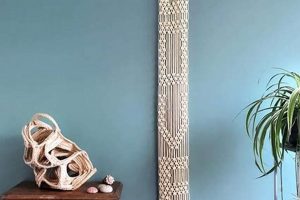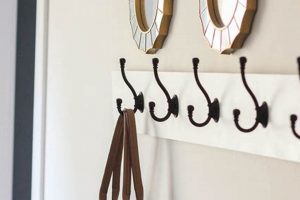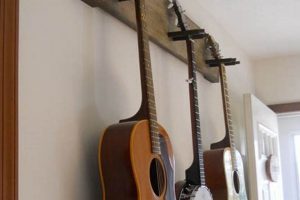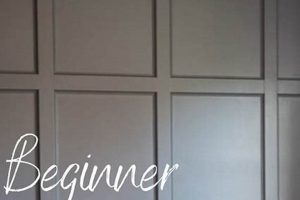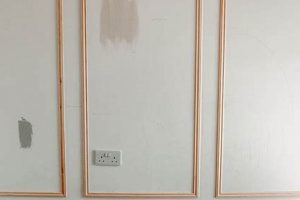A self-assembled illumination fixture affixed to a vertical surface provides a customizable and often cost-effective lighting solution. These projects encompass a broad range of designs, from repurposing existing materials to constructing entirely new units using readily available components. For example, a discarded mason jar could be transformed into a rustic sconce with the addition of a light socket and appropriate wiring.
The appeal of creating these lighting solutions stems from several advantages. It allows for personalization, enabling individuals to match dcor and express creative vision. Furthermore, it can represent a significant cost saving compared to purchasing commercially manufactured alternatives. Historically, resourceful individuals have modified and adapted existing technologies to create personalized home lighting, reflecting both practicality and artistic expression.
The subsequent sections will delve into the various aspects of constructing personalized wall-mounted illumination. Topics covered will include essential safety considerations, material selection, wiring techniques, and design ideas to inspire unique and functional additions to interior spaces.
Essential Considerations for Constructing Wall-Mounted Illumination
The following guidelines ensure a safe and successful fabrication of personalized lighting solutions. Adherence to these recommendations mitigates potential hazards associated with electrical work and improper construction.
Tip 1: Prioritize Electrical Safety. Disconnect power at the circuit breaker before commencing any wiring. Utilize a non-contact voltage tester to confirm the absence of current. Ground all metallic components to prevent electrical shock.
Tip 2: Select Appropriately Rated Components. Ensure all electrical components, including wiring, sockets, and switches, are rated for the intended voltage and amperage. Consult local electrical codes for specific requirements.
Tip 3: Use Correct Wiring Techniques. Employ properly sized wire connectors for all splices. Secure connections within junction boxes. Avoid exposing bare wires. A securely wired connection minimizes the risk of short circuits and fires.
Tip 4: Choose Suitable Mounting Hardware. The selected fasteners and mounting brackets must adequately support the weight of the completed fixture. Account for the wall material (drywall, plaster, wood) and use appropriate anchors when necessary. Insufficient support can lead to the fixture detaching and potentially causing damage or injury.
Tip 5: Consider Heat Dissipation. When utilizing incandescent or halogen bulbs, ensure adequate ventilation around the bulb to prevent overheating. LED bulbs generate less heat and may be a safer alternative in enclosed designs.
Tip 6: Employ Proper Wire Management. Secure wiring within the fixture to prevent chafing or accidental disconnection. Use strain relief to protect wiring connections from stress.
Tip 7: Inspect and Test the Finished Fixture. Before permanent installation, carefully examine all wiring connections for tightness and proper insulation. After installation, test the fixture’s functionality and ensure it operates without any unusual noises or smells.
By adhering to these guidelines, the fabrication of a custom wall-mounted light fixture can be undertaken safely and with a higher likelihood of a successful outcome. This approach minimizes potential electrical hazards and ensures the long-term functionality of the project.
The subsequent section will provide detailed instructions on assembling a specific wall light design, incorporating the safety precautions outlined above.
1. Electrical safety
The construction of a personalized wall-mounted light fixture inherently involves working with electrical circuits. As such, electrical safety represents a paramount concern directly influencing the integrity and operational security of the completed project. A failure to adhere to established safety protocols introduces significant risks, including electrical shock, fire hazards, and damage to property. Improper wiring, inadequate grounding, or the use of inappropriately rated components can lead to catastrophic consequences. For example, a loose connection may cause arcing, potentially igniting nearby flammable materials, while the absence of a grounding path elevates the risk of electrocution should a short circuit occur.
The selection of Underwriters Laboratories (UL) listed components and the meticulous execution of wiring connections according to National Electrical Code (NEC) standards are critical for mitigating these risks. Furthermore, a thorough understanding of circuit breaker functionality and the ability to correctly identify and isolate circuits prior to commencing work are essential skills. Consider the potential scenario where a metallic fixture housing contacts a live, ungrounded wire. Without a functional ground connection, the fixture becomes energized, posing a significant threat to anyone who touches it. Proper grounding provides a low-resistance path for fault current, tripping the circuit breaker and preventing electrocution.
In summary, electrical safety is not merely an ancillary consideration but an intrinsic element inextricably linked to the creation of a self-assembled wall-mounted illumination fixture. Its implementation dictates the functional longevity and safety profile of the project. A comprehensive approach, encompassing meticulous technique and stringent adherence to electrical standards, is indispensable for safeguarding the user and the surrounding environment from potential harm.
2. Component Selection
The selection of appropriate components constitutes a foundational element in the successful design and construction of self-assembled wall-mounted illumination. The choice of materials and electrical hardware directly impacts safety, functionality, and the overall aesthetic of the finished light fixture. Inadequate consideration of component specifications can lead to operational failures, electrical hazards, or a visually unappealing outcome.
- Electrical Wiring Gauge and Insulation
The gauge of electrical wiring must be sufficient to handle the amperage draw of the intended light source. Undersized wiring can overheat, leading to insulation breakdown and potential fire hazards. Furthermore, the insulation material must be appropriate for the environment in which the light fixture will operate. For example, high-temperature wiring is necessary in close proximity to incandescent bulbs. A failure to select the correct wire gauge or insulation can compromise safety and shorten the lifespan of the fixture.
- Lampholder (Socket) Type and Rating
The lampholder must be compatible with the type of bulb selected (e.g., incandescent, LED, halogen) and possess an appropriate voltage and wattage rating. An improperly rated lampholder can overheat, melt, or fail prematurely. For instance, using a lampholder designed for low-wattage bulbs with a higher-wattage incandescent bulb could result in a fire. Furthermore, the lampholder’s construction material should be durable and resistant to corrosion, especially in damp environments.
- Mounting Hardware and Fasteners
The chosen mounting hardware, including screws, brackets, and anchors, must be capable of supporting the weight of the completed light fixture securely. The type of wall material (drywall, plaster, wood) dictates the appropriate type of anchor. Insufficiently sized or improperly installed fasteners can result in the light fixture detaching from the wall, posing a safety hazard and potentially damaging the wall surface. Selecting corrosion-resistant materials is also crucial in areas prone to moisture.
- Light Source (Bulb) Characteristics
The selection of the bulb is vital for both functionality and aesthetics. The wattage of the bulb determines the brightness, while the color temperature (measured in Kelvin) influences the atmosphere of the space. Consider the energy efficiency of the bulb (LEDs are generally the most efficient). The bulb’s shape, size, and base type must also be compatible with the lamp holder and the overall design of the fixture. Failure to consider these factors can result in inadequate or inappropriate illumination.
The interplay between these component characteristics dictates the overall performance and longevity of the self-assembled wall-mounted light fixture. A holistic approach to component selection, incorporating safety considerations, functional requirements, and aesthetic preferences, ultimately contributes to a successful and enduring lighting solution. The quality of each component will influence the function and lifespan of the complete custom light.
3. Mounting Integrity
Mounting integrity is a crucial determinant of the safety and longevity of any self-assembled wall-mounted illumination fixture. It directly relates to the fixture’s ability to remain securely attached to the wall surface under various conditions, including the weight of the fixture itself, potential vibrations, and accidental impacts. Insufficient mounting integrity can lead to catastrophic failure, resulting in the fixture detaching and potentially causing injury or property damage. The root cause of inadequate mounting often lies in the selection of inappropriate fasteners, inadequate wall anchors, or improper installation techniques. The effect is a compromised connection between the fixture and the wall, increasing the risk of detachment over time.
The choice of mounting hardware must align with both the weight of the fixture and the composition of the wall. Drywall, for instance, necessitates the use of specialized anchors capable of distributing the load over a larger area, preventing the screws from simply pulling out. Solid wood walls offer greater inherent holding power, but still require appropriately sized and spaced screws to ensure a secure connection. Consideration must also be given to the location of wall studs. Securing the fixture directly to a stud provides the most robust mounting solution. Real-world examples of mounting failures often involve oversized or heavy fixtures attached to drywall using only standard screws, without proper anchors. The practical significance of understanding these principles lies in the prevention of such failures and the assurance of a safe and reliable lighting installation.
In conclusion, mounting integrity is not merely a cosmetic concern but a fundamental requirement for ensuring the safety and durability of any wall-mounted lighting solution. Attention to detail in fastener selection, anchor type, and installation technique is paramount. The challenges associated with achieving robust mounting can be mitigated through careful planning, a thorough understanding of wall construction, and the application of appropriate hardware and methods. The importance of solid mounting practices becomes even clearer when coupled with the safe wire install of the lighting to prevent any future issues with power. The absence of adequate mounting integrity represents a critical vulnerability that can compromise the entire project.
4. Design Aesthetics
Design aesthetics play a pivotal role in self-assembled wall-mounted illumination, dictating the fixture’s visual appeal and its harmonious integration within the intended environment. The aesthetic considerations extend beyond mere ornamentation, influencing the perceived value and functionality of the lighting solution. A well-conceived aesthetic enhances the space while a poorly executed design can detract from it. Proper implementation of aesthetic principles will create a more appealing and functional final product.
- Material Selection and Texture
The choice of materials, including wood, metal, glass, or repurposed items, significantly impacts the fixture’s aesthetic. The texture of these materials, whether smooth, rough, polished, or matte, contributes to the overall visual and tactile experience. For instance, a reclaimed wood fixture with a rough texture can evoke a rustic aesthetic, while a sleek metal fixture with a polished finish conveys a modern sensibility. The selected materials should complement the existing dcor and reflect the desired style.
- Form and Proportion
The shape and size of the fixture, along with the relative proportions of its components, contribute to its visual balance and harmony. A disproportionately large or small fixture can appear awkward or out of place. Similarly, the shape of the fixture, whether geometric, organic, or abstract, influences its perceived style and visual impact. A minimalist design might emphasize clean lines and simple geometric forms, while a more elaborate design might incorporate curves and intricate details.
- Color and Finish
The color and finish of the fixture significantly affect its visual prominence and its ability to blend in or stand out within the room. A brightly colored fixture can serve as a focal point, while a neutral-toned fixture can seamlessly integrate into the existing dcor. The finish, whether glossy, matte, or textured, influences the way light interacts with the fixture’s surface, affecting its perceived brightness and visual depth.
- Style and Theme Coherence
The fixture’s overall style should align with the room’s existing dcor and the desired aesthetic theme. A mismatch in style can create visual disharmony and detract from the overall ambiance. For example, installing an industrial-style fixture in a traditionally decorated room might appear incongruous. Coherence in style contributes to a cohesive and visually pleasing environment.
The successful integration of these aesthetic elements is paramount for creating a self-assembled wall-mounted light fixture that not only provides illumination but also enhances the visual appeal and overall ambiance of the space. A harmonious blend of material, form, color, and style contributes to a lighting solution that is both functional and aesthetically pleasing. It serves to improve the overall sense of design in the room.
5. Light output
The light emitted from a self-assembled wall-mounted fixture is a critical determinant of its functionality and suitability for the intended space. The characteristics of this illumination, specifically its intensity, color temperature, and distribution, directly influence the ambiance, task performance, and overall user experience. The selection of an inappropriate light source can render the fixture ineffective for its intended purpose or create an undesirable visual environment. For example, a dimly lit fixture in a workspace may impede productivity, while a harsh, overly bright light in a relaxation area can induce discomfort. Therefore, a thorough understanding of light output metrics is essential for optimizing the design of these customized lighting solutions.
Consider the practical implications of light output in several contexts. A reading nook benefits from a focused, warm-toned light source with moderate intensity, facilitating comfortable reading without causing eye strain. Conversely, a kitchen countertop demands a brighter, cooler-toned light source with broader distribution to ensure adequate illumination for food preparation. The type of bulb selected (e.g., LED, incandescent, halogen) significantly impacts these characteristics. LEDs offer greater energy efficiency and longer lifespans compared to traditional incandescent bulbs, and they are available in a wide range of color temperatures and intensities. Halogen bulbs provide a bright, white light, but they also generate more heat and consume more energy. Careful consideration of these trade-offs is crucial for achieving the desired light output while minimizing energy consumption and safety risks.
In summary, light output is an indispensable component of a customized wall-mounted illumination fixture. Its attributes directly influence the fixture’s functionality, aesthetic appeal, and impact on the surrounding environment. Proper bulb selection combined with the correct fixture design will result in pleasant lighting for the space. The challenge lies in balancing the desired light characteristics with energy efficiency, safety considerations, and the overall design aesthetic, ensuring that the final product effectively serves its intended purpose. Careful planning and execution will create the best final results.
Frequently Asked Questions Regarding DIY Wall-Mounted Illumination
This section addresses common inquiries and concerns related to the design, construction, and safety of self-assembled wall-mounted light fixtures. The information provided aims to offer clarity and guidance for individuals undertaking such projects.
Question 1: Is specialized electrical knowledge required to construct a functional wall-mounted light fixture?
While comprehensive expertise is not mandatory, a foundational understanding of basic electrical wiring principles is essential for ensuring safe and reliable operation. Individuals lacking such knowledge should consult with a qualified electrician.
Question 2: What are the primary safety precautions to observe when working with electrical components?
The most critical safety measures include disconnecting power at the circuit breaker before commencing work, utilizing a non-contact voltage tester to verify the absence of current, grounding all metallic components, and employing appropriately rated electrical components and wiring techniques.
Question 3: What type of wall anchors are suitable for supporting a heavy wall-mounted light fixture on drywall?
For heavier fixtures, toggle bolts or molly bolts are generally recommended. These anchors provide a secure connection by distributing the load over a larger area on the backside of the drywall. Avoid using simple drywall screws, as they offer insufficient holding power.
Question 4: How does one determine the appropriate wattage for a wall-mounted light fixture in a specific room?
The ideal wattage depends on the room size, intended use, and desired level of illumination. General guidelines suggest higher wattage for task lighting in work areas and lower wattage for ambient lighting in relaxation spaces. Consult a lighting guide for specific recommendations.
Question 5: Is it permissible to use repurposed materials in the construction of a wall-mounted light fixture?
Repurposed materials can be incorporated, provided they are structurally sound and compatible with the electrical components. Ensure that any repurposed components are thoroughly cleaned and inspected for potential hazards before use. All repurposed components must safely function in the final construction.
Question 6: What steps should be taken to ensure proper heat dissipation when using incandescent or halogen bulbs in an enclosed wall-mounted light fixture?
Adequate ventilation is crucial to prevent overheating. Design the fixture with sufficient air vents or openings to allow for the free flow of air around the bulb. Consider using LED bulbs, which generate significantly less heat than incandescent or halogen alternatives.
The information outlined above addresses several key aspects of constructing personalized wall-mounted illumination. The safety is a top priority, so proceed with caution when dealing with electrical components.
The subsequent section will provide detailed instructions on assembling a specific wall light design, incorporating the safety precautions outlined above.
Conclusion
This exploration has sought to illuminate the multifaceted nature of the self-assembled wall-mounted illumination fixture. Key points addressed have included electrical safety, component selection, mounting integrity, design aesthetics, and light output characteristics. The informed application of these principles is paramount for achieving a functional, safe, and aesthetically pleasing lighting solution. A lack of attention to any of these crucial elements increases the risk of project failure and potential hazards.
The creation of personalized lighting is an exercise demanding both creativity and technical competence. Prudent implementation of best practices remains essential for individuals seeking to undertake such projects. Prioritizing safety and rigorous application of established guidelines ensures the creation of a durable and functional lighting element while minimizing potential risks. The continued development of new materials and lighting technologies presents ongoing opportunities to refine and improve these illumination solutions.



